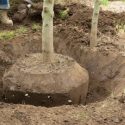Transplanting shrubs and ornamental plants is fairly common, but sometimes it is desirable to transplant a mature tree as well. There are many reasons why a property owner may wish to move a mature tree, including new additions to a building, aesthetics, or because a tree is not thriving in the location where it was originally planted.
The first step is to consider when moving a mature tree is whether you can safely transplant the tree by yourself, or if you will need to hire a tree professional. While transplanting a small shrub can be a fairly simple process, moving a mature tree is much more involved. Transplanting a mature tree requires planning months in advance and will also usually involve a very large and heavy root ball. Larger trees will typically require the assistance of a professional.
Root pruning is an essential step in preparing a mature tree for transplant.
Tree roots may extend a considerable direction from the tree – usually much further than can be excavated for the transplant. Root pruning involves digging a trench of an appropriate diameter around the tree and severing all roots passing through the trench. Pruning the roots in this way encourages the growth of feeder roots closer to the trunk to allow the tree to survive being transplanted. Root pruning must be performed either in the fall after leaves have dropped or in the spring before new buds have emerged. As a general rule, you should plan on a root ball 12 inches in diameter for every one inch of trunk diameter.
Once it is time to transplant the tree, you will want to tie up the lower branches to protect them and to provide room to dig up the root ball. Dig outside of the trench that was used to prune the roots. After digging down to the desired depth, you can cut in beneath the root ball at about a 45-degree angle. After the root ball has been excavated it should be wrapped in burlap to prevent damage, and to allow watering if the tree will not be replanted immediately. Remember that trees with a root ball can be quite heavy, and larger trees will require machinery to safely move.
Planting the tree involves first digging a hole approximately 50 percent wider than the root ball and about the same depth as the hole from which the tree was removed. The burlap should be untied from around the root ball, but may be left in the hole beneath the tree. After placing the tree in the new hole, replace the subsoil and water, then replace the topsoil and water again. Many trees will require stakes for support until the root system has become established.
Follow-up care for transplanted trees includes watering periodically.
While the amount and frequency of watering will vary between trees and sites, it is generally preferred to deep water at periodic intervals. Remember that too much or too little water can result in the tree not surviving the transplant.
Transplanting a mature tree is possible in many situations, but may be complicated and difficult. Brother Tree & Lawn Service has professional arborists who have experience with transplanting a variety of trees. Contact us today at 203-767-2915 to learn how we can help with transplanting trees or with other tree care needs.
